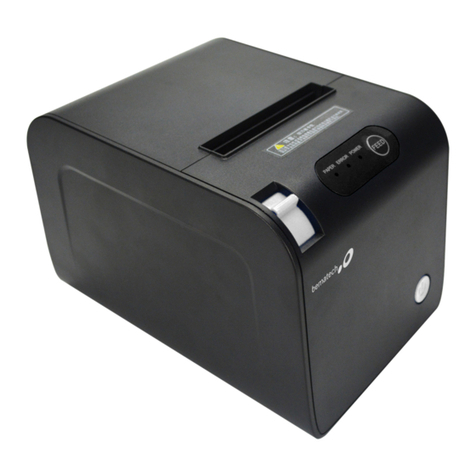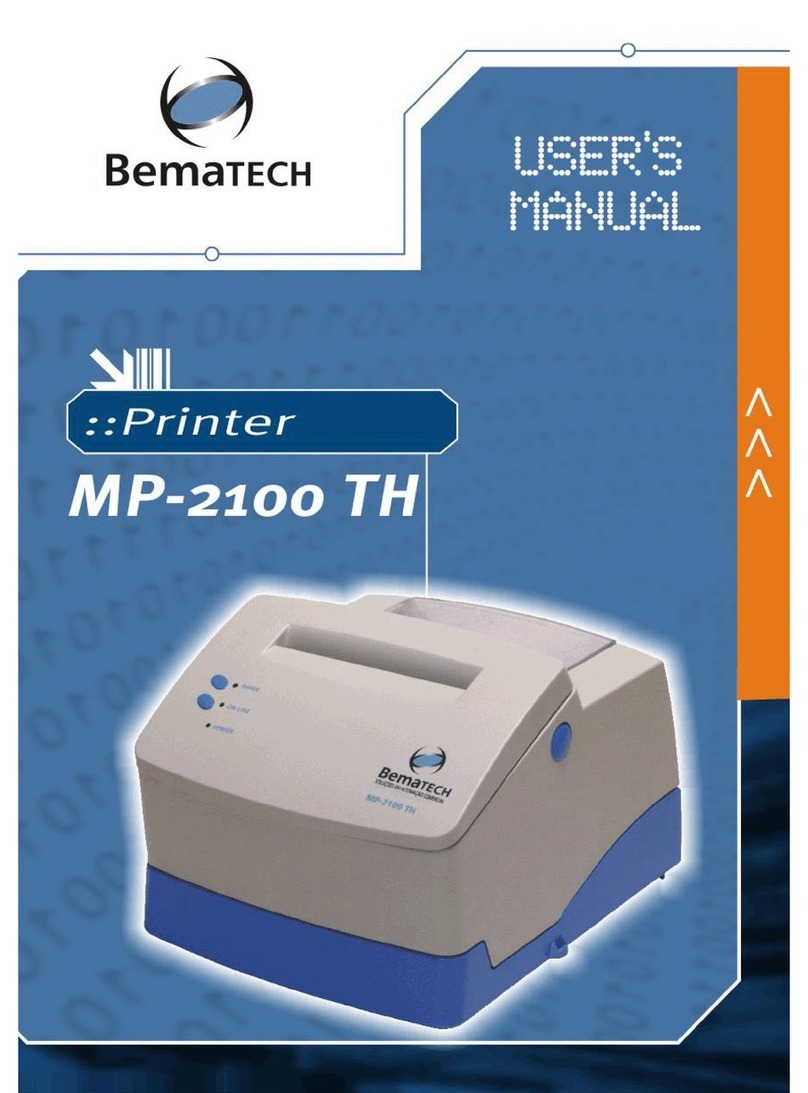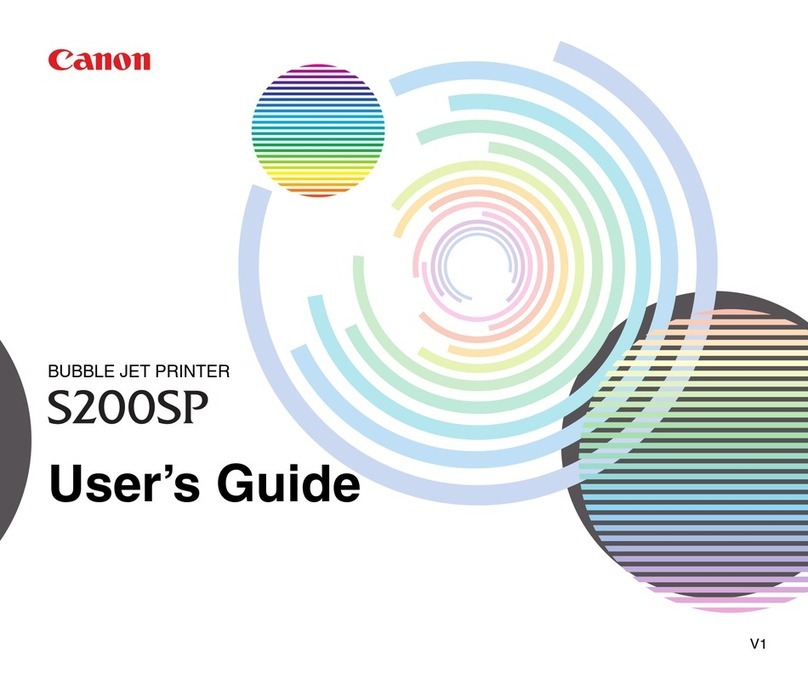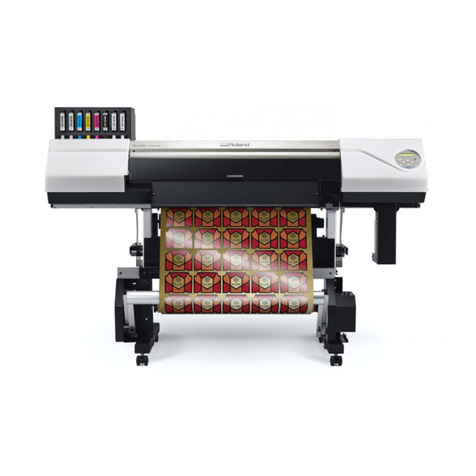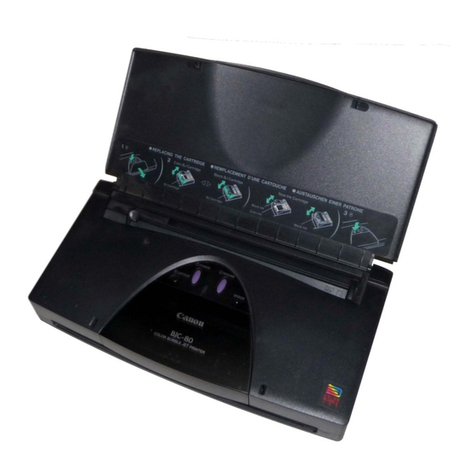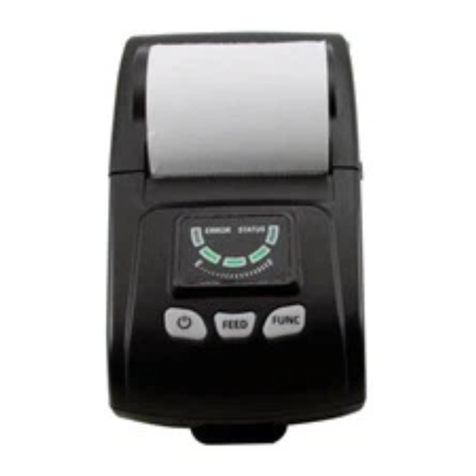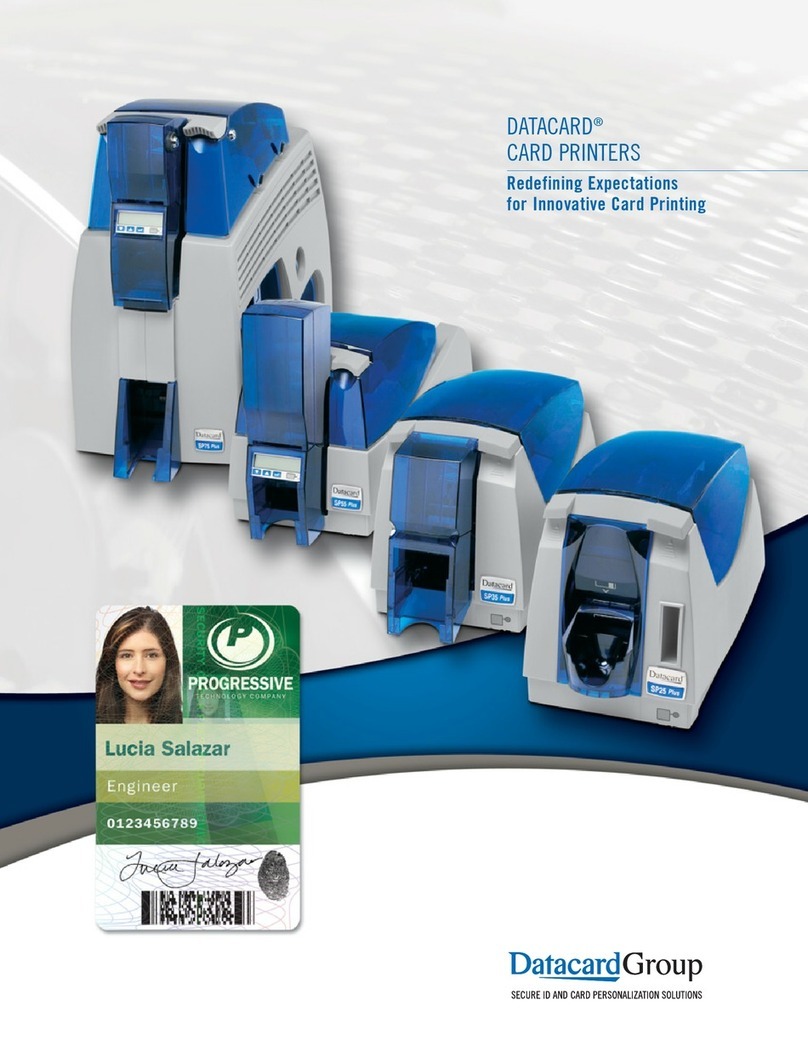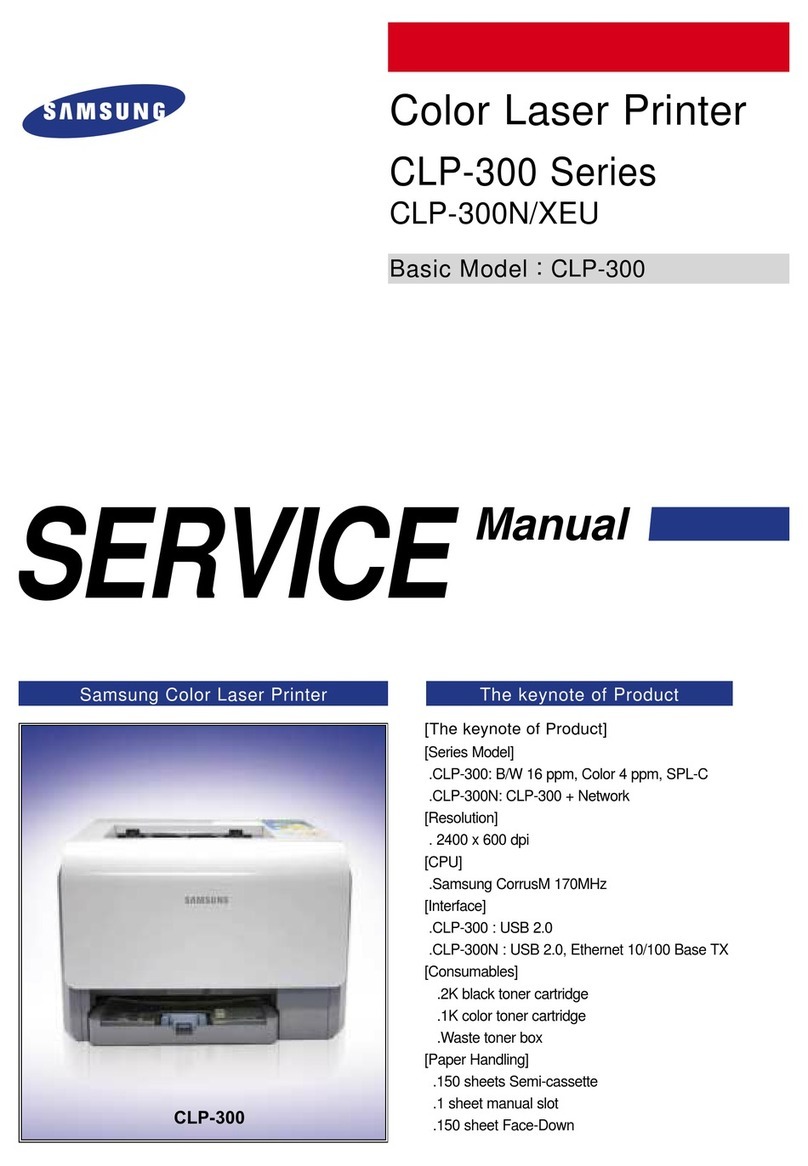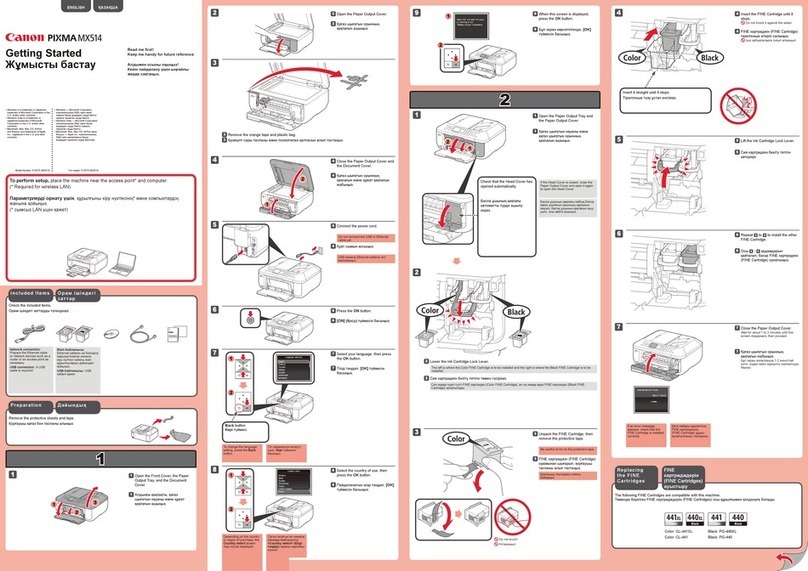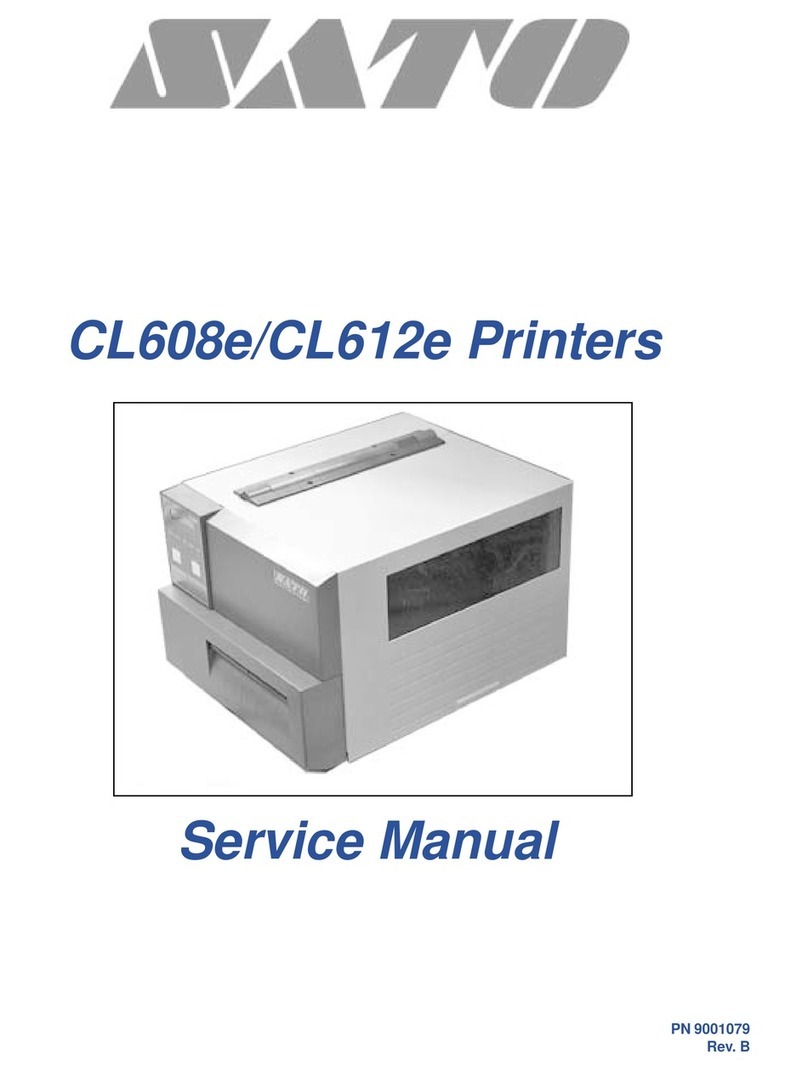Bematech LR200M Owner's manual

LR200M Mobile Thermal Receipt Printer
PROGRAMMING MANUAL

LR200M Programming Manual V1.0
Copyright© by Bematech
All rights reserved.
No part of this publication may be copied, reproduced, adapted or translated without the prior
written permission of Bematech, except when allowed by patent rights.
Information in this publication is purely informative, subjected to change without notice and no
liability is assumed with respect to its use. However, as product improvements become available,
Bematech will make every effort to provide updated information for the products described in this
publication. The latest version of this manual can be obtained through Bematech web site:
www.bematechus.com
Notwithstanding the other exceptions contained in this Manual, the consequences and
responsibility are assumed by the Purchaser of this product or third parties as a result of: (a)
intentional use for any improper, unintended or unauthorized applications of this product, including
any particular purpose; (b) unauthorized modifications, repairs, or alterations to this product; (c)
use of the product without complying with Bematech Corporation’s operating and maintenance
instructions; (d) use of the product as component in systems or other applications in which the
failure of this could create a situation where personal injury or material damages may occur. In the
events described above, Bematech and its officers, administrators, employees, subsidiaries,
affiliates and dealers shall not be held responsible or respond by any claim, costs, damages,
losses, expenses and any other direct or indirect injury, as well as claims which alleges that
Bematech was negligent regarding the design or manufacture of the product.
Bematech shall not be liable against any damages or problems arising from the use of any options
or any consumable products other than those designated as original Bematech products or
approved products by Bematech
Any product names or its logotypes mentioned in this publication may be trademarks of its
respective owners and shall be here recognized.
Product warranties are only the ones expressly mentioned in the User’s Manual. Bematech
disclaims any and all implied warranties for the product, including but not limited to implied
warranties of merchantability or fitness for a particular purpose. In addition, Bematech shall not be
responsible or liable for any special, incidental or consequential damages or lost profits or savings
arising from the use of the product by the Purchaser, the User or third parties.
BEMATECH
999 S. Oyster Bay Rd
Building #104
Bethpage, NY 11714
TEL: (516) 248-0400
FAX: (516) 248-0443
Email: support@bematechus.com
www.bematechus.com

LR200M Programming Manual V1.0
1
TABLE OF CONTENTS
1Overview ...........................................................................................................................................3
2Command List ....................................................................................................................................5
3Command Set Details .........................................................................................................................8
HT..............................................................................................................................................................8
LF...............................................................................................................................................................8
CR..............................................................................................................................................................9
DC2 T........................................................................................................................................................9
DLE EOT n..................................................................................................................................................9
ESC SO n..................................................................................................................................................11
ESC DC4 n................................................................................................................................................12
ESC SP n ..................................................................................................................................................12
ESC ! n.....................................................................................................................................................12
ESC $ nL nH .............................................................................................................................................13
ESC % n ...................................................................................................................................................14
ESC & y c1 c2 [x1 d1...d(y x1)]...[xk d1...d(y xk)] ..............................................................................14
ESC m nL nH d1...dk.............................................................................................................................17
ESC - n .....................................................................................................................................................19
ESC ? n ....................................................................................................................................................20
ESC @......................................................................................................................................................20
ESC { n .....................................................................................................................................................20
ESC 2 .......................................................................................................................................................21
ESC 3 n ....................................................................................................................................................21
ESC 7 n1 n2 n3 ........................................................................................................................................21
ESC 8 n1 n2 .............................................................................................................................................22
ESC 9 n ....................................................................................................................................................22
ESC B n ....................................................................................................................................................22
ESC D n1...nk NUL ...................................................................................................................................23
ESC E n ....................................................................................................................................................23
ESC G n....................................................................................................................................................24
ESC J n .....................................................................................................................................................24
ESC M n...................................................................................................................................................24

LR200M Programming Manual V1.0
2
ESC R n ....................................................................................................................................................25
ESC V n ....................................................................................................................................................26
ESC a n ....................................................................................................................................................26
ESC c 5 n..................................................................................................................................................27
ESC d n ....................................................................................................................................................27
ESC t n.....................................................................................................................................................27
ESC v n ....................................................................................................................................................28
FS ! n .......................................................................................................................................................29
FS &.........................................................................................................................................................30
FS ............................................................................................................................................................30
FS p n m ..................................................................................................................................................31
FS q n [xL xH yL yH d1...dk]1...[xL xH yL yH d1...dk]n .............................................................................32
GS ! n.......................................................................................................................................................34
GS * x y d1…d(x×y×8)..........................................................................................................................35
GS / m .....................................................................................................................................................36
GS B n......................................................................................................................................................37
GS H n .....................................................................................................................................................37
GS L nL nH ...............................................................................................................................................38
GS a n......................................................................................................................................................38
GS f n.......................................................................................................................................................40
GS h n......................................................................................................................................................40
GS k m d1...dk NUL GS k m n d1...dn ..................................................................................................40
GS r n ......................................................................................................................................................43
GS v 0 m xL xH yL yH d1....dk ..................................................................................................................44
GS w n.....................................................................................................................................................45
GS x n ......................................................................................................................................................46
GS ( k pL pH cn fn n1 n2 (cn=49, fn=65).................................................................................................46
GS ( k pL pH cn fn n (cn=49, fn=67).........................................................................................................46
GS ( k pL pH cn fn n (cn=49, fn=69).........................................................................................................47
GS ( k pL pH cn fn m d1…dk (cn=49, fn=80)............................................................................................47
GS ( k pL pH cn fn m (cn=49, fn=81) .......................................................................................................48
GS ( k pL pH cn fn m (cn=49, fn=82) .......................................................................................................48

LR200M Programming Manual V1.0
3
1 Overview
The LR200M is a high quality mobile printer using thermal technology for printing. It is
compatible with most point-of-sale systems on the market. The LR200M portable
printer optimizes the mobile checkout process and helps accelerate business at the
Point of Sale. The printer is equipped with both Bluetooth and WiFi interface, enabling
it to work with POS applications designed for either wireless communications.
The rubber protection and non-slip design makes the light weight printer drop-
resistant and easy to work with, making it ideal for mobile operations.
1
11
2
4
10
9
8
7
3
5
6
12

LR200M Programming Manual V1.0
4
1. Status Indicator
2. Feed Key
3. Battery indicator
4. Power Key
5. Printer top cover
6. USB interface connector
7. Power supply connector
8. Error indicator
9. Printer body
10. Transparent cover
11. Cover opening lever
12. Battery

LR200M Programming Manual V1.0
5
2 Command List
A command set describes the behavior of the printer when sequences of bytes are received
through the communication interface. The command set available with LR200M is ESC/POS®.
It is a standard defined by Seiko Epson Corporation. ESC/POS® commands can be classified as
executing or setting. An executing command cause the printer to execute something and does
not affect further incoming data. On the other hand, a setting command cause the printer to
change its internal flags that may affect incoming data. ESC/POS® commands supported by
LR200M are summarized in the following table.
Type
Command
Name
Print Command
LF
Print and line feed
CR
Print and carriage return
HT
JMP to the next TAB position
ESC D n
Set horizontal tab positions
ESC J n
Print and Feed n dots paper
ESC d n
Print and Feed n lines
ESC = n
Toggle the printer online or offline
Line spacing
Command
ESC 2
Select default line spacing
ESC 3 n
Set line spacing
ESC a n
Select justification
ESC SO
Select Double Width mode
ESC DC4
Disable Double Width mode
GS L nL nH
Set the left blank margin with dots
ESC $ nL nH
Set absolute print position
ESC B n
Set left blank margin by characters
Character
Command
ESC ! n
Select print mode
GS ! n
Set or Cancel the double width and height
GS B
Turn white/black reverse printing mode
ESC V n
Turn 90°clockwise rotation mode on/off
ESC M n
Select character font
ESC G n
Turn on/off double-strike mode
ESC E n
Set or Cancel bold font
ESC SP n
Set the space between chars
ESC { n
Turn upside-down printing mode on/off

LR200M Programming Manual V1.0
6
Type
Command
Name
ESC - n
Set the underline dots (0,1,2)
ESC % n
Select/Cancel user-defined characters
FS &
Select Chinese mode
FS .
Select character mode
FS!
Set print mode for Kanji characters
ESC &
Define user-defined characters
ESC ? n
Cancel user-defined characters
ESC R n
Select and international character set
ESC t n
Select character code table
Bit Image
Command
ESC *
Select bit-image mode
GS *
Define downloaded bit image
GS /
Print downloaded bit image
GS v
Print the bitmap with width and height
FS p n m
Print NV bitmap
FS q n
Define NV bitmap
Init Command
ESC @
Initialize printer
Status
Command
DLE EOT n
Real-time status transmission
GS r n
Transmit status
GS a n
Enable/Disable ASB
Bar Code
Command
GS H
Select printing position of human readable characters
GS h
Set bar code height
GS w
Set bar code width
GS k
Print bar code
GS x
Set barcode printing left space
Printer Control
Command
ESC 7 n1 n2 n3
Setting Control Parameter Command
ESC 8 n1 n2
Sleep parameter
ESC 9 n
Select Chinese code format
DC2 T
Print test page
ESC c 5 n
Select/Cancel panel button
QR code and pdf
command
GS ( k pL pH cn
fn n1 n2 (fn=65)
Set QR Code model
GS ( k pL pH cn
fn n1 n2 (fn=67)
Set QR Code module size

LR200M Programming Manual V1.0
7
Type
Command
Name
GS ( k pL pH cn
fn n1 n2 (fn=69)
Set QR code correction level error
GS ( k pL pH cn
fn m d1…dk
(fn=80)
Store QR code data in the symbol storage area
GS ( k pL pH cn
fn m (fn=81)
Print QR Code in symbol storage area
GS ( k pL pH cn
fn m (fn=82)
Request size information of QR Code in symbol storage area

LR200M Programming Manual V1.0
8
3 Command Set Details
This section presents detailed information about each ESC/POS® command implemented by
the LR200M printer. Some terms used in the description of ESC/POS command set need
further explanation, as described below.
Print buffer: a buffer that stores the image data to be printed.
Print buffer full: the state where the print buffer is full. If new print data is input while
the print buffer is full, the data in the print buffer is printed out and a line feed is
executed. This is the same operation as the LF operation.
Start of line: a state that satisfies the following conditions:
Print buffer is empty.
There is no data to print (including portions of data skipped due to HT).
The print position has not been specified by the ESC $ command.
Printable area: the maximum space available for printing. The printable area under
ESC/POS for LR200M is specified by horizontal direction (48mm or 1.89”).
Printing area: a value set by the command. It must be always less than or equal to
printable area.
Ignore: a state in which all codes, including parameters, are read in and discarded, and
nothing happens.
MSB: Most Significant Bit; LSB: Least Significant Bit
HT
[Name] Horizontal tab
[Format] ASCII HT
Hex 09
Decimal 9
[Description] Moves the print position to the next horizontal tab position.
[Notes]
This command is ignored unless the next horizontal tab position has been set.
If the next horizontal tab position exceeds the printing area, the printer sets the
printing position to [printing area width + 1].
Horizontal tab positions are set with ESC D.
If this command is received when the printing position is at [printing area width + 1],
the printer executes print buffer-full printing of the current line and horizontal tab
processing from the beginning of the next line.
[Reference] ESC D
LF
[Name] Print and line feed

LR200M Programming Manual V1.0
9
[Format] ASCII LF
Hex 0A
Decimal 10
[Description] Prints the data in the print buffer and feeds one line, based on the cu rrent line
spacing.
[Note] This command sets the print position to the beginning of the line.
[Reference] ESC 2, ESC 3
CR
[Name] Print and carriage return
[Format] ASCII CR
Hex 0D
Decimal 13
[Description] When automatic line feed is enabled, this command functions the same as LF; when
automatic line feed is disabled, this command is ignored.
[Notes]
This command line feed is ignored with a serial interface model.
Sets the print starting position to the beginning of the line.
[Reference] LF
DC2 T
[Name] Print test page
[Format] ASCII DC2 T
Hex 12 54
Decimal 18 94
[Description] Print test page
DLE EOT n
[Name] Real-time status transmission
[Format] ASCII DLE EOT n
Hex 10 04 n
Decimal 16 4 n
[Range] 1 n 4
[Description] Transmits the selected printer status specified by n in real-time, according to the
following parameters:
n = 1: Transmit printer status
n = 2: Transmit offline status
n = 3: Transmit error status
n = 4: Transmit paper roll sensor status

LR200M Programming Manual V1.0
10
[Notes]
The status is transmitted whenever the data sequence <10>H<04>H<n>
(1 n 4) is received.
Example:
In ESC m nL nH d1...dk, d1=<10>H, d2=<04>H, d3=<01>H
Do not use this command within another command that consists of 2 or more bytes.
Example:
If you attempt to transmit ESC 3 n to the printer, but DLE EOT 3 interrupts
before n is received, the code <10>H for DLE EOT 3 is processed as the
code for ESC 3 <10>H.
The printer transmits the current status. Each status item is represented by one-byte
of data.
The printer transmits the status without confirming whether the host computer can
receive data.
The printer executes this command upon receiving it.
This command is executed even when the printer is offline, the receive buffer is full, or
there is an error status with a serial interface model.
With a parallel interface model, this command cannot be executed when the printer is
busy. This command is executed even when the printer is offline or in error status, with
a parallel interface model.
When Auto Status Back (ASB) is enabled using the GS a command, the status
transmitted by the DLE EOT command and the ASB status must be differentiated.
n = 1: Printer status
Bit
Off/On
Hex
Decimal
Function
0
Off
00
0
Not used. Fixed to Off.
1
On
02
2
Not used. Fixed to On.
2
On
04
4
Not used. Fixed to On.
3
-
-
-
Undefined.
4
On
10
16
Not used. Fixed to On.
5.6
--
--
--
Undefined.
7
Off
00
0
Not used. Fixed to Off.
n = 2: Offline status
Bit
Off/On
Hex
Decimal
Function
0
Off
00
0
Not used. Fixed to Off.
1
On
02
2
Not used. Fixed to On.
2
Off
00
0
Cover is closed.
On
04
4
Cover is opened.
3
Off
00
0
Paper is not being fed by using the FEED button.
On
08
8
Paper is being fed by the FEED button.
4
On
10
16
Not used. Fixed to On.

LR200M Programming Manual V1.0
11
5
Off
00
0
Paper present.
On
20
32
Printing stopped because of paper out.
6
Off
00
0
No error.
On
40
64
Error occurred.
7
Off
00
0
Not used. Fixed to Off.
n = 3: Error status
Bit
Off/On
Hex
Decimal
Function
0
Off
00
0
Not used. Fixed to Off.
1
On
02
2
Not used. Fixed to On.
2
--
--
--
Undefined.
3
Off
00
0
Not used. Fixed to Off.
4
On
10
16
Not used. Fixed to On.
5
Off
00
0
No unrecoverable error.
On
20
32
Unrecoverable error occurred.
6
Off
00
0
No auto-recoverable error.
On
40
64
Auto recoverable error occurred.
7
Off
00
0
Not used. Fixed to Off.
Bit 6: Bit 6 is On when printing is stopped due to high print head temperature until the
print head temperature drops sufficiently or when the paper roll cover is opened
during printing.
n= 4: Continuous paper sensor status
Bit
Off/On
Hex
Decimal
Function
0
Off
00
0
Not used. Fixed to Off.
1
On
02
2
Not used. Fixed to On.
2.3
-
-
-
Undefined.
4
On
10
16
Not used. Fixed to On.
5.6
Off
00
0
Paper roll sensor: Paper present.
On
60
96
Paper roll end detected by paper roll sensor.
7
Off
00
0
Not used. Fixed to Off.
[Reference] GS a
ESC SO n
[Name] Select Double Width mode
[Format] ASCII ESC SO n
Hex 1B 0E n
Decimal 27 14 n
[Description] Select Double Width mode. To turn double width off, use LF or DC4 command.

LR200M Programming Manual V1.0
12
ESC DC4 n
[Name] Disable Double Width mode
[Format] ASCII ESC DC4 n
Hex 1B 14 n
Decimal 27 20 n
[Description] Disable Double Width mode
ESC SP n
[Name] Set right-side character spacing
[Format] ASCII ESC SP n
Hex 1B 20 n
Decimal 27 32 n
[Range] 0 n 255
[Description] Sets the character spacing for the right side of the character to [n×0.125 mm (n×
0.0049")].
[Notes] The right-side character spacing for double-width mode is twice the normal value.
When characters are enlarged, the right-side character spacing is n times normal
value.
This command does not affect the setting of Kanji characters.
This command sets values independently in standard mode.
[Default] n = 0
ESC ! n
[Name] Select print mode(s)
[Format] ASCII ESC ! n
Hex 1B 21 n
Decimal 27 33 n
[Range] 0 n 255
[Description] Selects print mode(s) using n as follows:
Bit
Off/On
Hex
Decimal
Function
0
Off
00
0
Character Font A (12×24).
On
01
1
Character Font C (9×17).
1
Off
00
0
Reverse printing mode not selected
On
02
2
Reverse printing mode selected
2
Off
00
0
Upside-down printing mode not selected
On
04
4
Upside-down printing mode selected

LR200M Programming Manual V1.0
13
3
Off
00
0
Emphasized mode not selected
On
08
8
Emphasized mode selected
4
Off
00
0
Double-height mode not selected
On
10
16
Double-height mode selected
5
Off
00
0
Double-width mode not selected
On
20
32
Double-width mode selected
6
-
-
-
Undefined
7
Off
00
0
Underline mode off
On
80
128
Underline mode on
[Notes] When both double-height and double-width modes are selected, quadruple-size
characters are printed.
The printer can underline all characters, but cannot underline the space set by HT
or 90clockwise rotated characters.
The thickness of the underline is that selected by ESC , regardless of the
character size.
When some characters in a line are double or more height, all the characters in the
line are aligned at the baseline.
ESC E can also turn on or off emphasized mode. However, the setting of the last
received command is effective.
GS ! can also select character size. However, the setting of the last received
command is effective.
Emphasized mode is effective for alphanumeric and Kanji. All print modes except
emphasized mode are effective only for alphanumeric.
[Default] n = 0
[Reference] ESC E, GS !
ESC $ nL nH
[Name] Set absolute print position
[Format] ASCII ESC $ nL nH
Hex 1B 24 nL nH
Decimal 27 36 nL nH
[Range] 0 nL 255
0 nH 255
[Description] Sets the distance from the beginning of the line to the position at which subsequent
characters are to be printed.
The distance from the beginning of the line to the print position is [(nL + nH×256)×
0.125 mm].
[Notes] Settings outside the specified printable area are ignored.
In standard mode, the horizontal motion unit (x) is used.

LR200M Programming Manual V1.0
14
ESC % n
[Name] Select/cancel user-defined character set
[Format] ASCII ESC % n
Hex 1B 25 n
Decimal 27 37 n
[Range] 0 n 255
[Description] Selects or cancels the user-defined character set.
When the LSB of n is 0, the user-defined character set is canceled.
When the LSB of n is 1, the user-defined character set is selected.
[Notes] When the user-defined character set is canceled, the built-in character set is
automatically selected.
n is available only for the least significant bit.
[Default] n = 0
[Reference] ESC &, ESC ?
ESC & y c1 c2 [x1 d1...d(y x1)]...[xk d1...d(y xk)]
[Name] Define user-defined characters
[Format] ASCII ESC &y c1 c2 [x1 d1...d(y ×x1)]...[xk d1...d(y ×xk)]
Hex 1B 26 y c1 c2 [x1 d1...d(y ×x1)]...[xk d1...d(y ×xk)]
Decimal 27 38 y c1 c2 [x1 d1...d(y ×x1)]...[xk d1...d(y ×xk)]
[Range] y = 3
32 c1 c2 126
0 x 12 (when Font A (12×24) is selected)
0 x 9 (when Font C (9×17) is selected)
0 d1 ... d(y ×xk) 255
[Description] Defines user-defined characters.
y specifies the number of bytes in the vertical direction.
c1 specifies the beginning character code for the definition, and c2 specifies the
final code.
x specifies the number of dots in the horizontal direction.
[Notes] The allowable character code range is from ASCII code <20>H to <7E>H (95
characters).
It is possible to define multiple characters for consecutive character codes. If only
one character is desired, use c1 = c2.
d is the dot data for the characters. The dot pattern is in the horizontal direction
from the left side. Any remaining dots on the right side are blank.
The data to define user-defined characters is (y×x) bytes.
Set a corresponding bit to 1 to print a dot or 0 not to print a dot.

LR200M Programming Manual V1.0
15
This command can define different user-defined character patterns for each font.
To select a font, use ESC !.
User-defined characters and a downloaded bit image cannot be defined
simultaneously. When this command is executed, the downloaded bit image is
cleared.
The user-defined character definition is cleared when:
1) ESC @ is executed.
2) GS is executed.
3) ESC ? is executed.
4) The power is turned off.
When user-defined characters are defined in Font C (9 17), only the most
significant bit of the 3rd byte of data in vertical direction is effective.
[Default] The internal character set
[Reference] ESC %, ESC ?
[Example]
When Font A (12×24) is selected.

LR200M Programming Manual V1.0
16
d1= <0F>H d4 = <30>H d7 = <40>H . . . .
d2 = <03>H d5 = <80>H d8 = <40>H . . . .
d3 = <00>H d6 = <00>H d9 = <20>H . . . .
When font C (9×17) is selected.

LR200M Programming Manual V1.0
17
d1 = <1F>H d4 = <08>H d7 = <10>H...
d2 = <FF>H d5 = <08>H d8 = <04>H...
d3 = <80>H d6 = <00>H d9 = <00>H...
ESC m nL nH d1...dk
[Name] Select bit-image mode
[Format] ASCII ESC m nL nH d1...dk
Hex 1B 2A m nL nH d1...dk
Decimal 27 42 m nL nH d1...dk
[Range] m = 0, 1, 32, 33
0 nL 255
0 nH3
0 d 255
[Description] Selects a bit-image mode using m for the number of dots specified by nL and nH, as
follows:
m
Mode
Vertical Direction
Horizontal Direction
Number of Dots
Dot Density
Dot Density
Number of Data (k)
0
8-dot single-density
8
67.7 dpi
101.6 dpi
nL + nH ×256
1
8-dot double-density
8
67.7 dpi
203.2 dpi
nL + nH ×256
32
24-dot single-density
24
203.2 dpi
101.6 dpi
(nL + nH ×256)3
33
24-dot double-density
24
203.2 dpi
203.2 dpi
(nL + nH ×256)3

LR200M Programming Manual V1.0
18
[Notes] If the value of m is out of the specified range, nL and the data following are
processed as normal data.
The nL and nH indicate the number of dots in the bit image in the horizontal
direction. The number of dots is calculated by nL + nH 256.
If the bit-image data input exceeds the number of dots to be printed on a line, the
excess data is ignored.
d indicates the bit-image data. Set a corresponding bit to 1 to print a dot or to 0 not
to print a dot.
After printing a bit image, the printer returns to normal data processing mode.
This command is not affected by print modes (emphasized, double-strike,underline,
character size, or white/black reverse printing), except upside-down printing mode.
The relationship between the image data and the dots to be printed is described in
figure below.
When 8-dot bit image is selected:
When 24-dot bit image is selected:
Other manuals for LR200M
2
Table of contents
Other Bematech Printer manuals

Bematech
Bematech MP200 User manual
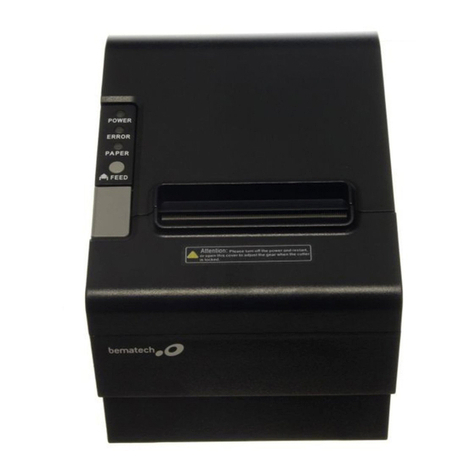
Bematech
Bematech LR2000 User manual

Bematech
Bematech MP-4000 TH User manual
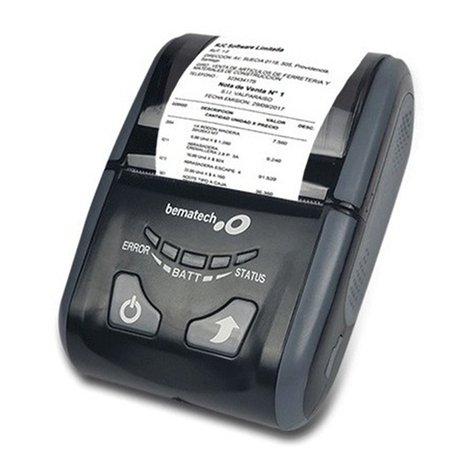
Bematech
Bematech LR200M User manual
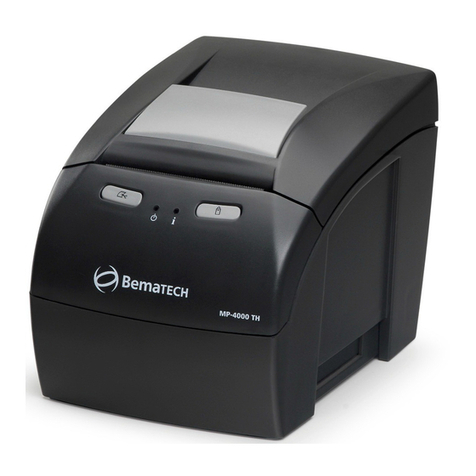
Bematech
Bematech MP-4000 TH User manual
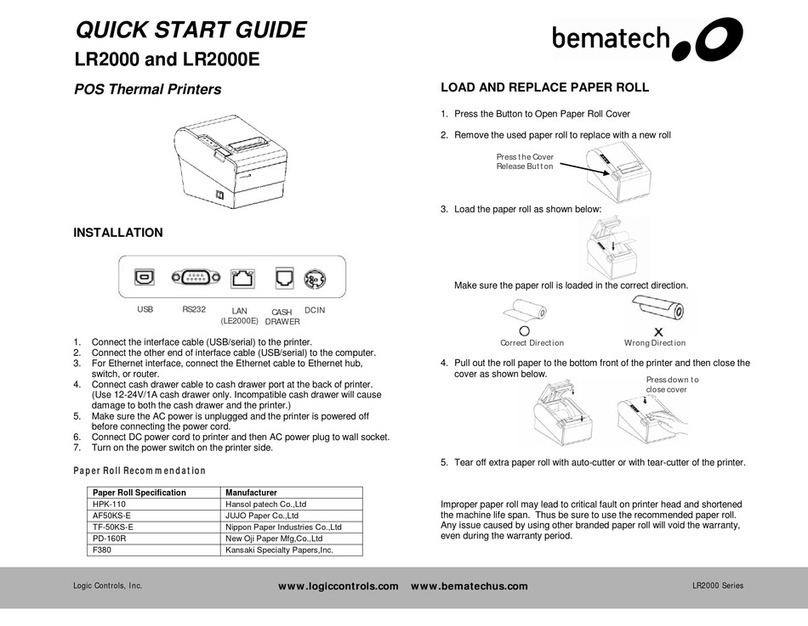
Bematech
Bematech LR2000 User manual

Bematech
Bematech LR2000 Owner's manual
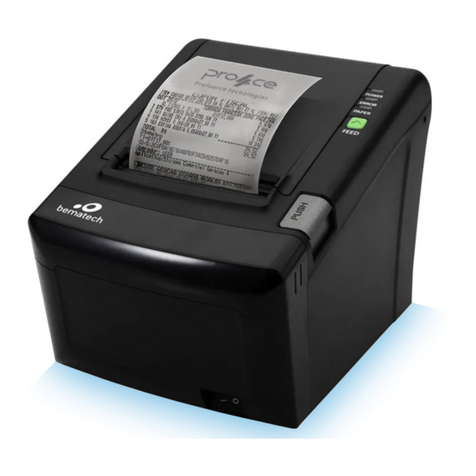
Bematech
Bematech MP-2500 TH User manual

Bematech
Bematech LR200M User manual
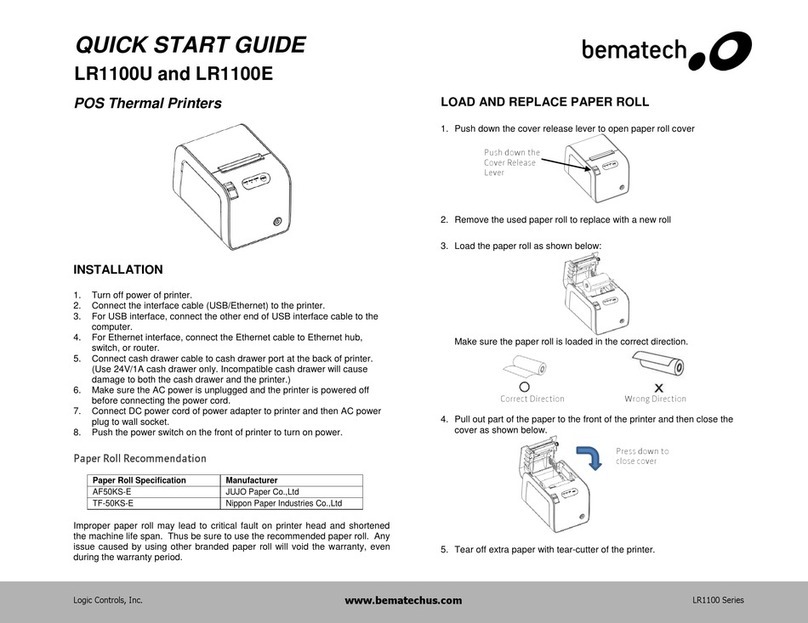
Bematech
Bematech LR1100U User manual
